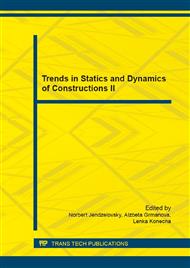[1]
K. Washizu, Variational Methods in Elasticity and Plasticity, third ed., Pergamonn Press, New York, (1982).
Google Scholar
[2]
S. Saigal, I. Yang, Nonlinear Dynamic Analysis with 48 DOF Curved Thin Shell Element, International Journal for Numerical Methods in Engineering 22 (1985) 1115-1128.
DOI: 10.1002/nme.1620210611
Google Scholar
[3]
O. C. Zienkiewicz, R. L. Taylor, The Finite Element Method, Vol. 2, Solid and Fluid Mechanics, Dynamics and Non-Linearity, fourth ed., McGraw-Hill, London, (1991).
Google Scholar
[4]
M. A. Crisfield, Non-Linear Finite Element Analysis of Solids and Structures, Wiley&Sons, London, (1996).
Google Scholar
[5]
ANSYS User's Manual 13. 0, Swanson Analysis Systems, Inc., (2010).
Google Scholar
[6]
Z. Kala, J. Kala, M. Skaloud, B. Teply, Sensitivity Analysis of the Effect of Initial Imperfections on the Stress State in the Crack-Prone Areas of Breathing Webs, In: Proceedings of the Fourth Int. Conf. on Thin-walled Structures, 2004, Loughborough, England, UK, pp.499-506.
DOI: 10.1201/9781351077309-56
Google Scholar
[7]
M. Psotny, J. Ravinger, Post-Buckling Behaviour of Imperfect Slender Web, Engineering Mechanics Vol. 14, No. 6 (2007) 423-429.
Google Scholar
[8]
A. S. Volmir, Stability of deformable systems, Nauka, Moscow, 1967. (in Russian).
Google Scholar
[9]
P. S. Bulson, The Stability of Flat Plates, Chatto&Windus, London, (1970).
Google Scholar
[10]
F. Bloom, D. Coffin, Handbook of Thin Plate Buckling and Postbuckling, Chapman&Hall/CRC, Boca Raton, (2001).
Google Scholar
[11]
J. Rhodes, Some observations on the post-buckling behaviour of thin plates and thin-walled members, Thin-walled structures Vol. 41, No. 2-3 (2003) 207-226.
DOI: 10.1016/s0263-8231(02)00088-5
Google Scholar
[12]
J. Ravinger, Vibration of Imperfect Thin-Walled Panel. Part 1: Theory and Illustrative Examples. Part 2: Numerical Results and Experiment, Thin-Walled Structures Vol. 19, No 1 (1994) 1-36.
DOI: 10.1016/0263-8231(94)90002-7
Google Scholar
[13]
M. Psotny, Total Potential Energy Levels in the Post-Buckling, in: Proceedings of 13th International Scientific Conference VSU, 2013, Sofia, Bulgaria, Vol. I., pp. I- 296-299.
Google Scholar
[14]
J. Ravinger, M. Psotny, Stable and Unstable Paths in the Post-Buckling Behaviour of Slender Web, in: Proceedings of Coupled Instabilities in Metal Structures, Roma, 2004, p.67 – 75.
Google Scholar
[15]
Z. Bittnar, J. Sejnoha, Numerical Methods in Structural Mechanics 2, Publishing House CVUT, Praha, 1992. (in Czech).
Google Scholar
[16]
M. Psotny, Stable and unstable paths in geometrically nonlinear problems, Publishing House SvF STU, Bratislava, 2004. (in Slovak).
Google Scholar


